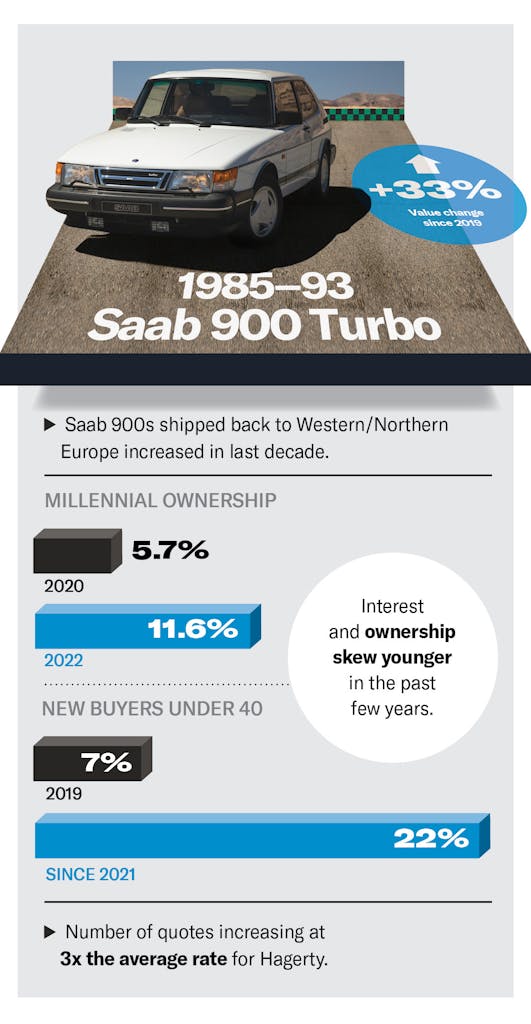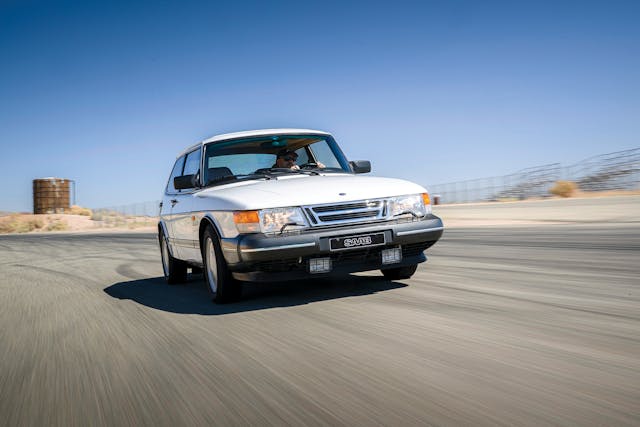2023 Bull Market Pick: 1985–93 Saab 900 Turbo
Welcome back to the Hagerty Bull Market List, our annual deep dive into the collector cars (and bikes) climbing the value ranks. This vehicle is one of 11 chosen for the 2023 installment of the List. To see the other 10, click here.
The new look of performance. That’s how Saab—for Svenska Aeroplan Aktiebolaget, or Swedish Airplane Company—described the 900 when the carmaker unveiled its newest model in 1978. It wasn’t quite a new look, however, styled as it was after the outgoing 99, although its longer wheelbase (by 2 inches) and increased overall length (by 8.4 inches) added real-world space to a car destined to charm more than one generation of enthusiasts with its own brand of quirk.
Both three- and five-door body styles were offered, and all of those doors closed with bank-vault solidity. Base power came from a fuel-injected 2.0-liter inline-four originally designed by Triumph. All 115 horses went toward the front wheels through a four-speed manual (five post-1983) or optional automatic. A turbocharger was available from the start, its 135 horsepower enough to propel the 2700-pound car to 111 mph while returning 19 mpg.
In addition to making turbocharged fun reliable in an era not known for fun or reliability, Saab loaded its sporty premium compact with thoughtful ergonomic touches. A split dash featured intuitively placed driver controls for everything, for instance. There were also novel safety features, like a telescopically collapsible steering column and the ignition key tumbler placed between the front seats to eliminate leg injuries in the event of a crash. The 900’s cabin air filter was an industry first, too.

For 1985, Saab fitted a DOHC 16-valve head to its Turbo models, now rated at 160 horsepower. 39,000 of the 900 were imported to the U.S. that year, the model’s highest volume during its 15-year run. A year later, the 16-valve head sat atop naturally aspirated engines, too, bumping them to 125 horses, and a Turbo convertible joined the lineup.
Ria Levine’s 1993 Turbo landed in the final year of production, after more than 900,000 of the 900 had sold worldwide. Levine grew up in a car family but wasn’t introduced to the 900 realm until 1984, when she rode along with her boss in his ’83 900 Turbo to client meetings. “I fell under the spell! The power, the comfort, and the ride were all intoxicating,” she says, “very much like a drug.” Eventually she bought his car, and then another, this time an ’84 Turbo. “It became my mom-mobile. I had two car seats in the back and the perfect diaper-changing space in the hatch—which can haul twice as much stuff as my SUV.” In 2000, shortly after selling that car and being Saabless for a few months, she found this one for sale close to home in California.

It is a joy to drive, perfectly preserved despite its 181,000 miles. In today’s era of high beltlines and gun-sight windows, the 900’s driving position and outward visibility are a revelation. The wraparound windshield puts the A-pillars completely out of sight, while the tight turning radius makes the car ridiculously easy to maneuver. The soft suspension means it leans like crazy, but it always feels planted and in control.
In fact, the 900 somehow still offers what Saab promised all those years ago. It may not be new, but the look of performance sure has aged gracefully.
***
1993 Saab 900 Turbo
Highs: Timeless looks; capable FWD layout goes where you point it; build quality and bullet-proof mechanicals; practical, cavernous interior.
Lows: Dwindling parts supply; dwindling talent to service them; an orphan from a dead company, meaning numbers will only shrink.
Price range: #1 – $29,800 #2 – $23,800 #3 – $19,000 #4 – $14,600

HAGERTY AUTO INTELLIGENCE SAYS:
Increasingly owned by next-generation enthusiasts, the Saab 900 Turbo appears to be spooling up for faster appreciation. Owners under age 40 have tripled since 2019 from a share of 7 percent to 22. Insurance quote growth for the 900 Turbo is three times faster than the overall growth rate at Hagerty. Exports back to Europe are up. While up 33 percent since 2019, values have lagged behind contemporary competitors such as the BMW 325i (+87 percent) and Volvo 240 (+42 percent). However, as demand emerges from new enthusiasts here and abroad, further appreciation looks likely.

Check out the Hagerty Media homepage so you don’t miss a single story, or better yet, bookmark it.



As a Saab owner since 1970, I LOVE to see this. From my first model 96 when Saab was only available in two trim packages – pro-whale or anti-nuke – to my present 1991 900 SPG, Saabs have never ceased to delight me. My present SPG is my 13th Saab with 240K miles. What a joy to drive! I am so pleased to see Saab belatedly get the recognition it deserves.
I miss both my Saab 900’s – one each first and second generation, both purchased used for very little money. Neither was a turbo, but they were very comfortable especially on a long trip, sturdy and relatively easy to repair and performance on snow-covered was incredible. I still keep watching the ads for a local, rust-free one.
I read years ago that Saab stood for “Sierra Alpha Alpha Bravo” to pay homage to the companies military aircraft manufacturing heritage.
@ David Dillon, that comes from an old ad from the Late 1980s / early 1990s. SAAB is the acronym from Svenska Aeroplan Aktiebolaget (AB) – Swedish Airplane Company to the rest of us. Check out the Vintage SAAB Club of North America if you’ve caught the bug…
Actually, the “SA” in SAAB stands for “Swedish Aircraft” (in Swedish, it’s “Svenska Aeroplan”). “AB” means “Inc.”.
Not surprising considering that I am seeing a few old Saab’s at car shows after not seeing them for such a long time.
I had only one 900–1988 SPG. It was a joy to drive but gave me headaches when it needed servicing. The engine was rebuilt with standard pistons, so when it blew up I shouldn’t have been surprised. A used engine worked fine and I drove it until the odometer read in the high 200s. I sold it a couple years ago, just before the market upturn. It was black with tan leather interior and sold well even back then. I like to service my own cars and just learning how to replace the alternator brushes was a pain, not to mention getting to the alternator bolts…Too many troublesome servicings to waste your time, or mine anymore. My INFINITI gives me similar performance without the service headaches. Best of luck to all of you older 900 owners!!!!
I’ve a 1981 Saab 99 two-door, a 1985 900 5-door ,& a 900iSE 5-door. All in use. I’ve owned Saab’s since 1987 and have had 11 of mainly non turbo ones as they ride better. They are tough, usually reliable and drive wonderfully! The 1990 900 is on winter tyres & is perfect for this time of the year.
J’ai 52 ans , je suis un ancien mécanicien/ technicien de chez Saab des années 90 j’ai fait mon apprentissage de mecanique chez Saab , aujourd’hui je suis prof de mécanique bateau . Je roule en 900 au quotidien depuis près de 25 ans , j’ai eu 30 saab 900 , je repare des saab depuis + 30 ans . Il me reste 3 saab que je vais garder a vie , une 900 aero US de 1985 , une 900 aero de 1989 , et ma femme roule avec une 900 aero de 1993 . Ces voitures roulent tous les jours , toutes distances , en vacances weekend , partout . Nos filles ont grandi dans ces voitures et aujourd’hui notre grande fille passe son permis en conduite accompagné en conduisant une saab 900 turbo S
As a Saab owner since my mid-20s, and an enthusiast since early childhood, I absolutely love to see that Saab finally gets at least some of the recognition it always deserved. The classic 900 is the quintessential Saab: its durability, versatility, unique character and not least its performance (the small engine turbo that didn’t blow up the engine was a revolution that a tiny carmaker started, that was subsequently adapted by every other upscale automaker), all these things make it the best all-round car ever made.
Stefan, great article that captures well the sentiment around these cars.
While we all agree that the values of any classic 900 is appreciating, the years for the most usable and reliabel cars are as you’ve called out the ’85-93 year models equipped with the B202 16valve engine. During these years the core configuration of the stayed largely the same, which cannot be said of the 1979-1984 model years. However, that should not make the earlier years any less desirable so they should also be brought forth in the limelight. Also, there are multiple caveats within the later years that may restrict usability and thus value -for example, ’85’s had biodegradable wiring harnesses and most were parted out as a result; ’88/89’s had passive seatbelt restraints that when failed as most do, make the car a static display unless retrofitted with the standard seat belts.
There’s variety in the earlier years that is hard to value, yes: 1979 and 80’s had (by 1993 standards) an archaic turbo setup and 1981-84 had year over year changes to engine and turbo management systems and hardware, but they are not as nonstandard that they cannot be encompassed in a valuation tool – and they still capture the feeling that a 1993 has. Much like the Porsche 911, the SAAB 900 stayed largely the same for 14 years with significant changes under the hood.
I am glad that Hagerty’s is finally on to the value proposition of the classic SAAB 900, but I would ask for you to expand the valuation tools to account for 1979-1984 variants as well on top of the guidelines you’ve published here. There’s multiple errors and mismatched photos of your existing SAAB valuation tools that require more attention now that this is your #1 value pick for 2023. Over to you guys to fix.